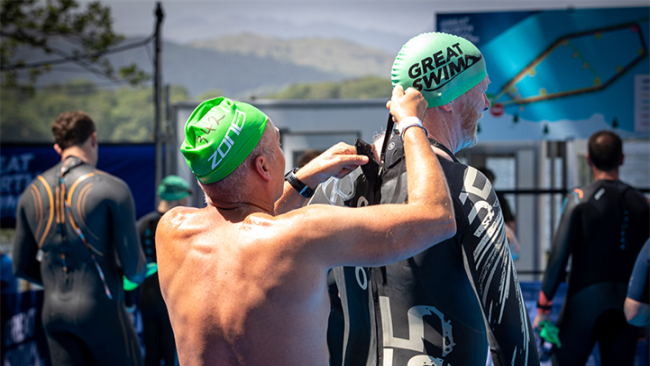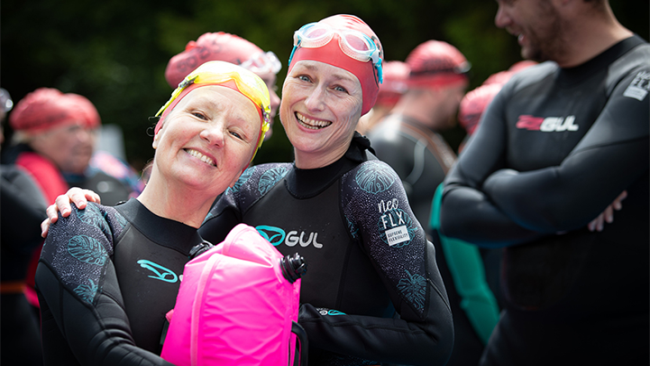Here’s what you need to know when choosing a wetsuit
Finding the right wetsuit can be daunting. With a wide range of brands, and each brand offering several models, the choice can seem overwhelming. What’s more, there is no wetsuit that is perfect for all swimmers, for all purposes. But if you choose carefully, you should be able to find a wetsuit that works for you and will give you several years of happy and comfortable swimming. So, in approximate descending order of importance, here are the criteria you should use to help find the best wetsuit for you at the Arla Great North Swim.
- Size and fit
Above all else, your wetsuit needs to fit. One that’s too small will constrict your movement and breathing, and will be uncomfortable. An oversized wetsuit will let in water, which stops it from keeping you warm and makes it heavy to swim in. Each wetsuit brand has its own size ranges and labels. While these often overlap, there are differences, so make sure you consult the correct chart for the brand you’re buying.
Size charts usually give a selection of measures such as weight, height and chest size. You may find (many people do) that your body doesn’t fit neatly into one size set. For example, you might find you are one size for height and chest, but a different one for weight. If you only differ slightly on the third measure, this normally isn’t a problem, but consult the brand’s guidance on which measures to prioritise.
A wetsuit that fits well will be snug against your skin. There shouldn’t be any loose bits where water can pool. You should have a tight but not choking seal around your neck and you should have full range of movement around your shoulders. The sleeves should reach to just above your wrists, and the legs to just above your ankle, without any bunching or overstretching in the material.

- Type of wetsuit
In most cases, a wetsuit designed for open water swimming or triathlon will serve you best. These are optimised for swimming. General purpose wetsuits tend to have less flexibility around the shoulders and lack some of the features you find in swim-specific suits. That said, if you’re doing one of the shorter swims (up to one mile or maybe two), and you already have a general-purpose wetsuit that fits – that you’re confident about swimming in – and you’re not ready to invest in a swimming wetsuit, then go ahead and use it. It won’t be as fast or comfortable, but you should still have an enjoyable swim.
A swimrun wetsuit is a possible option. However, these are usually “shorties” so offer less protection from the cold. Also, they aren’t as fast as a full swimming wetsuit.
- Price point
Swim-specific wetsuit prices range from around £100 to more than £700. In general, the more you pay, the more features you will find to help you swim faster. In particular, expensive suits tend to be the most flexible. However, there are trade-offs. One way in which expensive wetsuits achieve flexibility is through using thinner neoprene, which offers less protection from the cold and can be damaged more easily. Secondly, the buoyancy distribution may be better suited to swimmers who are already fast and have a good body position in the water. Mid and bottom range wetsuits may have more buoyancy around the hips and legs, which could give a boost to swimmers whose feet tend to sink.
Over a one-mile swim, the speed gains from a top-end suit will be measured in seconds rather than minutes. Unless you’re in it to win it, an entry or mid-level wetsuit will be more than adequate. For the longer swims, the improved flexibility of an expensive suit will help reduce fatigue, so may be worth considering if you have the funds.
- What stroke you swim
Swimming wetsuits are designed primarily for front crawl. If you swim breaststroke, you may find the leg buoyancy uncomfortably high, putting strain on your back. Consider using a wetsuit designed specifically for breaststroke. Alternatively, you could try a shortie wetsuit (such as a swimrun wetsuit) as these have less leg buoyancy. A final option could be to use the top half of a two-piece wetsuit, as long as you are comfortable with your legs getting cold.
- Zip direction
On some wetsuits, the zip is closed from the top down rather than the bottom up. This is supposed to make the wetsuit quicker to remove, which is only relevant in triathlon. Another advantage is that it’s harder for another swimmer to accidentally unzip you if they grab hold of your pull cord while swimming. The disadvantage is that they are almost impossible to zip up on your own. The zip direction makes no difference to your swim.

- Personal preference
Wetsuits have different cuts around the neck. What is comfortable for one person may feel too high or low for another. Unfortunately, it’s hard to tell what works for you without swimming in the suit. This is also true of the overall feel of the suit. If you can, try before you buy.
- Other considerations
I’ve done the Great North Swim when the water temperature in Windermere was as cold as 13 degrees and as warm as 19. If you are uncomfortable swimming at the low end of that range, look for a wetsuit that offers more warmth: check the thickness of the neoprene on the different parts of the suit or look for one specifically designed for lower temperatures. Also, think about how else you might use your wetsuit. Will you keep it exclusively for racing or do you want something for general outdoor swimming, for example?
Finally, make sure you practise swimming in your wetsuit before the event and ensure you know how to put it on correctly. Wetsuits tend to get more comfortable with use, and you will swim better and feel more confident if you are familiar with wearing it. Allow yourself plenty of time (at least 15 minutes) to put your suit on before your swim. Make sure you pull it up firmly but gently into your crotch and over your back and legs. If you rush this, you may not get an optimal fit and you also risk damaging it.
Once in the water, forget your wetsuit and enjoy the swim and the beautiful views around Windermere.
Simon Griffiths
Founder & Publisher, Outdoor Swimmer
Author: Swim Wild and Free